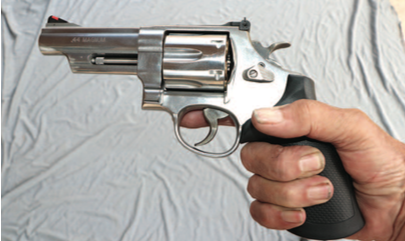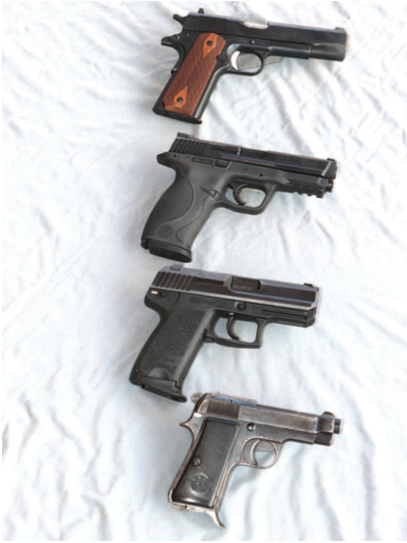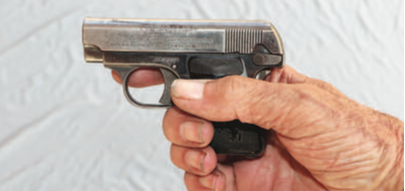
When considering a handgun for any purpose — hunting, plinking or defense, it is most important to address first things first. Hunters and shooters should first understand that “hand” and “gun” in a handgun scenario need to be considered in sequence, with “hand” going first.
Given all of the marketing hype, imagined scenarios, etc., it is easy to focus first on the gun — things like magazine or cylinder capacity, chambering, barrel length, etc. Those are all important but should be brought into the conversation a little later on.
One well-placed shot trumps multiple badly placed and/or missed shots.
Hence, the capacity of number of rounds or even the number of rounds fired are irrelevant if something doesn’t hit the
right place with the right stuff. Of all types of firearms, handguns are the most difficult to learn to shoot well for a number of reasons. The better the hand hold and the more consistent the hand hold, the better the shooter will be able to hit whatever it is that is being shot at. And the better the handgun fits an individual shooter’s hand, the easier it is to hit con- sistently and to be able to take advantage of whatever the inherent accuracy/power the specific handgun offers.
Consider the geometry and directions of force involved in shooting a handgun, regardless of whether it is a one or two-hand hold.
The handgun must be held firmly and the hold must be consistent from shot to shot. Concurrently, the trigger must be depressed directly to the rear — no pulled or pushed to one side or the other because of the forces exerted by the trigger finger.
At the same time, the sights must be aligned/handgun pointed well enough to deliver accuracy good enough to hit the desired spot. In other words, there is a lot going on, all at the same time and/or in repetitious sequences.
To complicate matters, all of these things need to be repeated for each shot, and that is not counting the need to recover from any recoil, which can cause the hold to change, etc.
Proper gun fit goes a long way toward solving that entire list of concerns. In other words, proper gun fit eliminates a situation where the gun gets in its own way.
There are other things to consider downstream, like the physical size and weight of the gun, but for openers, let’s just talk about gun fit.
People’s hand sizes, shapes and strengths vary greatly. A handgun that is perfect for one hunter or shooter may be a disaster for others. Gun fit always is a personal matter.
If the handle on a handgun is too small for a given hand, it will be difficult to make consistent hits because the gun will be moving around in the hand with each shot, and the hand can’t contract enough to make up the difference for a firm hold.

If the handle is too large, it may be difficult for the hunter or shooter to hold it well enough to put it on target, or the trigger finger may not be able to pull directly rearward, which means the act of pulling the trigger will pull the gun off-target.
For most handguns, it is difficult to decrease the size of the handle significantly. This means that smaller hands should shoot smaller guns.
It is possible to make the handle on many handguns bigger by changing the grip panels, etc., or even adding girth to the handle via anything ranging from layers of tape to actual custom grips.
Most mid-size handguns are configured to work at least okay for the “average” shooter with “average” size hands. For hand-guns of “average” size, weight and recoil, there is enough margin that most folks can shoot these kinds of handguns at least okay.
These are the full-size models chambered for cartridges like the 9mmP and .38 Special. Most folks can handle the recoil from those two cartridges within their personal performance parameters. But when the guns get small- er, like those intended for con- cealed carry, the calculus changes. As the size of the handgun gets smaller and smaller, there are more and more hand sizes that no longer are really viable.
For example, I have large hands and have trouble shooting some of the smaller handguns and literally almost can’t make some of the smallest “mouse” guns go bang. My hand wraps around them so significantly that I can’t make them function properly.
For me, a standard, full-size handgun is about as small as I can handle well. I can shoot the larger handguns much better. For example, a standard 1911 .45 ACP is marginally too small for me, as are most 9mmP and .38 Special handguns.
Yet, the larger guns fit superbly, which makes it much easier to hit what I shoot at. These handguns are models like S&W N and X Frame revolvers, Ruger Super Redhawk revolvers
and the Magnum Research BFR single-action revolvers.
Hence, my regular carry gun is a S&W Model 629 with 4- inch barrel in .44 Mag. It carries well concealed or open, and it fits my hand in a way that when I point it, it is on-target and squeezing the trigger doesn’t take it off-target.

However, that handgun would be a terrible choice for most shooters because it is big, heavy and delivers more recoil that many folks want to handle. Consider that the .44 Mag. is the most powerful of what I consider to be recreational cartridges — cartridges that one can shoot a lot, both informally and formally.
The larger handgun cartridges, usually used for hunting, tend to be neither introductory propositions or ones that lend themselves to high volume shooting. These include cartridges like the .454 Casull, .460 S&W, .500 S&W or rifle cartridges used in handguns like .375 JDJ, .308 Win. or .35 Rem.
As handguns get smaller, so do the cartridges they handle. Yes, there are quite small handguns chambered for the 9mmP, .40 S&W and .45 ACP, but “pocket” guns tend to be chambered for cartridges like the .380 ACP, .32 Auto or even one of the .22 rimfires.
All are potentially lethal, so any can be valid, assuming proper bullet placement, which can be quite challenging in many situations.
The bottom line when it comes to choosing a handgun for a particular purpose is to opt for one that fits the individual hand(s) of the shooter and then practice with it.
When the target is hit well, good things happen. When the target is hit badly or missed entirely, bad things can happen. Hitting the target well begins with a gun fit to the person who is shooting it.
Steve Comus is a nationally recognized hunting editor with Safari Club International and a WON Guns and Hunting Guns Editor. His column generally appears every other week in WON and he can be reached at scomus@cox.net.



